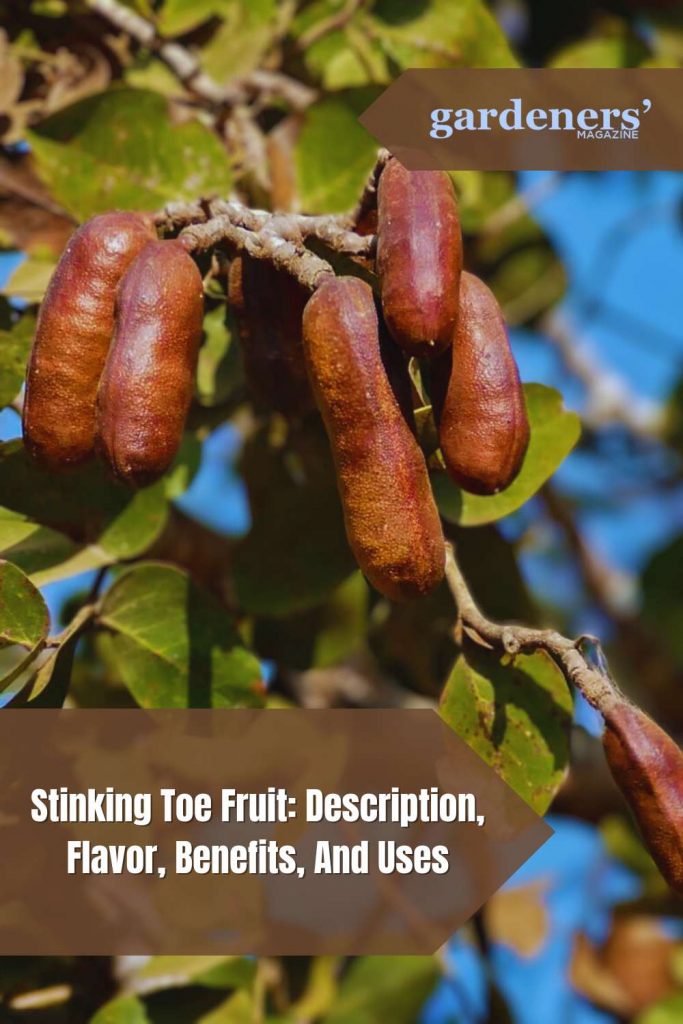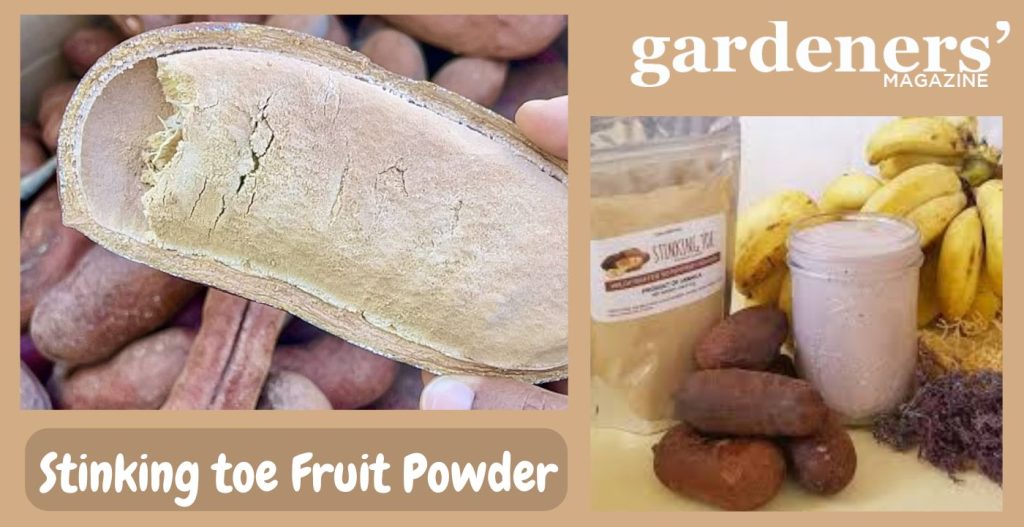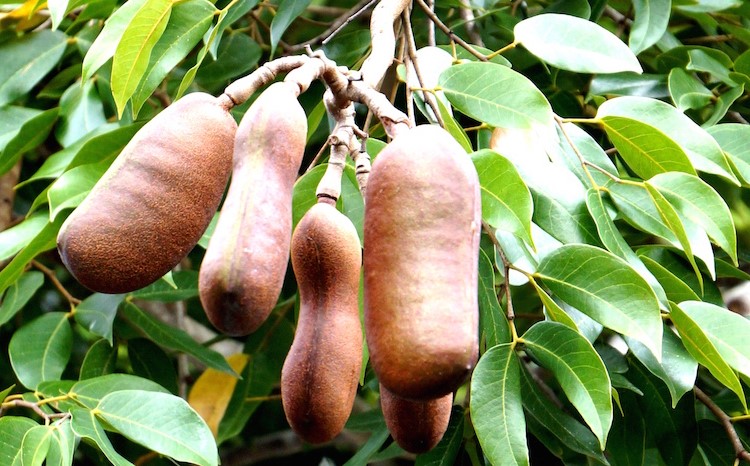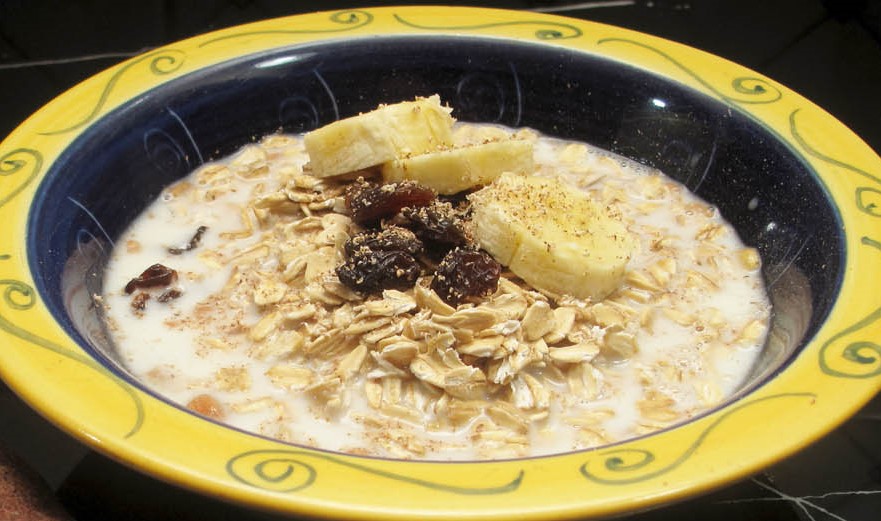Hello, fellow plant enthusiasts! Today, let’s talk about a rather unusually named but fascinating fruit – the Stinking Toe Fruit. Its name might raise some eyebrows, but this tropical gem has much more to offer than what its name suggests.The name ‘Stinking Toe’ comes from the fruit’s pod, which resembles a large, brown toe and has a rather strong, not-so-pleasant smell when cracked open. But don’t let the name fool you; the fruit inside is a hidden treasure!
Contrary to what its name might suggest, the pulp of the Stinking Toe Fruit is sweet and flavorful, often compared to a mix of vanilla and caramel. It’s a popular treat in its native regions and can be eaten raw or used in various culinary preparations. The fruit is also dried and ground into flour for baking.
What is Stinking Toe Fruit?
It is native to the Caribbean, originally hailing from Jamaica. It can also be found in other tropical regions, such as Puerto Rico, Cuba, Haiti, and the Dominican Republic. The tree that bears stinking toe fruit is a large shrub or small tree that grows between 8 and 15 feet tall. The trunk of this tree can reach up to 1 meter in diameter. The leaves are glossy green, and the fruit is round to oval, ranging from 2-5 cm long.
Stinking toe fruit has a unique and pungent odor that can be smelled even before the fruit is picked. This smell comes from the fruit’s flesh, which contains sulfur compounds that create an unpleasant smell when exposed to the air. Despite the odor, the fruit is a delicacy in many cultures and can be eaten raw or cooked into different dishes. It is also used in traditional medicinal remedies to treat various ailments.

History and Origin of Stinking Toe Fruit
Stinking toe fruit, also known as the jumbie bean, is a tropical fruit native to the Caribbean and Central America. It has been part of the local cuisine since ancient times. In Jamaica, stinky toe fruits have been used to make traditional dishes for centuries. The scientific name of this fruit is “Hymenaea courbaril.” This small reddish-brown fruit has an unpleasant odor and a unique taste that some consider sweet.
Stinking toe fruits are still popular in Caribbean and Central American cuisines. The sweet pulp can be eaten raw or used to make jams and jellies. A dried, stinking toe can be used as a spice, while the leaves can be boiled or fried in oil. Mixing the fruit with sugar and lime juice for an unusual cocktail is also popular.
Description of the Stinking Toe Fruit
It is a type of large pod found in Central America. It is also known as the Nesebar, Neseberry, or Mokosha. The fruit is oblong and can be up to 10 inches long and 4 inches wide. It has tough brown skin that can be difficult to break open. Once opened, the fruit’s interior contains a sticky, brown pulp and several large seeds.
The taste is unique and has been described as reminiscent of molasses or dates. The smell of Stinking Toe Fruit can be quite strong, hence its name. It is often eaten fresh or used in jams, jellies, wines and in powder form. While not widely available outside of Central America, it is an important part of the local culture and cuisine.

Flavor Profile of Stinking Toe Fruit
Stinking Toe Fruit is known for its unique flavor profile. It has a strong, pungent smell, and the taste can be described as sweet and earthy with a hint of tartness. The fruit has an unusual texture, which is slightly chewy yet also crisp at the same time. Its flesh is yellow to orange in color and contains several large seeds. The flavor of Stinking Toe Fruit is often compared to that of an overripe banana, although the scent and taste may vary between individuals. It pairs well with other tropical fruits like pineapple or mango and can be cooked into various dishes for added sweetness and texture.
🍈 Unveiling the exotic allure of Stinking Toe Fruit! 🌴 This mysterious tropical delight is sure to captivate your taste buds with its unique flavor and promise of health benefits. Embrace the adventure of trying something new!Click To TweetHealth Benefits of Stinking Toe Fruit
- Stinking Toe Fruit is a rich source of vitamins, minerals, and other beneficial compounds. It contains large amounts of vitamin C, which helps boost immunity levels and protect the body against disease.
- It also contains fiber, potassium, magnesium, and antioxidants that can help reduce inflammation and control your blood pressure.
- In addition, Stinking Toe Fruit is believed to have several medicinal properties. It has been used to treat colds, flu, headaches, and digestive issues like constipation and diarrhea. It can also help relieve stress and improve overall well-being.
Overall, this fruit is an interesting and unique fruit that offers a variety of health benefits in addition to its sweet and unique flavor. Whether eaten raw or cooked into a dish, this unusual fruit can make an excellent addition to any diet.
Cultivation of the Stinking Toe Fruit
This fruit has a hard, leathery shell. It is generally harvested when it falls off the tree and is usually black or dark brown with a strong smell. The fruit’s inner part, composed of three lobes, contains edible seeds that can be eaten raw or cooked.
Stinking toe fruit can be propagated by seed or cutting and is most often grown on hillsides. The trees are shallow-rooted and should be planted in well-drained soil with a pH of 6 to 7.5. They prefer full sun but will tolerate partial shade. The tree typically begins producing fruits after two years and will bear heavily for up to 30 years.
Overall, Stinking Toe Fruit is an easy-to-grow crop packed with nutrition and flavor and can be enjoyed in any number of dishes. It’s worth giving it a try.
Harvesting of the Stinking Toe Fruit
Harvesting the Stinking Toe Fruit is done by hand as they are very delicate and can easily be damaged. The fruit is ready for harvest when it turns brown and its skin becomes thin and wrinkled. It is best to pick the fruits in the early morning while they are still fresh, before the day’s heat has a chance to make them too soft. The fruit can then be carefully handled and placed in a clean container for storage.

Where Does Stinking Toe Fruit Grow?
Stinking toe fruit is a tropical fruit found in many regions worldwide. It is native to Central America and the Caribbean, including parts of Mexico, Belize, Guatemala, Panama, Costa Rica, Nicaragua, Honduras, Jamaica, and other islands. Stinking toe is also grown in some areas of South America, such as Colombia and Venezuela.
In Africa, it is found in parts of Ghana, Guinea-Bissau, and Nigeria. In Asia, it is grown mainly in India and on some islands of Southeast Asia, such as the Philippines. It is also found in Australia as “bumelia” or “sour plum.” The fruit can also be found growing wild in many areas around the world. In the United States, it is sometimes cultivated in Hawai’i and Florida.
This fruit is a unique and interesting tropical fruit in many parts of the world. It has become popular in recent years due to its sweet taste and health benefits, but it remains an enigma as its growth patterns are not fully understood. Regardless, it’s certainly worth trying if you ever come across some.
Where can the Best Quality Stinking Toe Fruit be brought?
The best quality of Stinking Toe Fruit can be found at specialty stores in Belize, as well as some Caribbean supermarkets and weekly markets. You can also find it on Amazon or eBay. As the fruit is not widely available outside its native country, you may have difficulty finding it fresh elsewhere.
If you’re looking for a more convenient option, buy dried and frozen Stinking Toe Fruit online or in specialty stores. This is a great way to enjoy the unique taste of this exotic fruit without having to make a trip to Belize or other Caribbean nations.
What is the Best Way to Store Stinking Toe Fruit?
The best way to store this fruit is to keep it in a cool and dry place. Avoid keeping the fruit near sources of heat or direct sunlight, as this will cause the fruit to ripen too quickly. It should also be stored away from strong-smelling foods like onions and garlic, as other foods can easily absorb their pungent odor.
Store the fruit in a refrigerator or root cellar to keep it fresh and flavorful for longer. Make sure to check on the fruit regularly to prevent over-ripening and discard any fruits that become overly soft or show signs of mold growth.
Finally, it can also be stored in an airtight container, such as a mason jar or plastic bag, to help preserve its freshness. With these tips in mind, you should have no problem keeping your Stinking Toe Fruit in perfect condition.
What are some Delicious Recipes Featuring Stinking Toe Fruit?
- Stinking Toe Fruit & Coconut Salad: Start with a base of lettuce and then add diced stinking toe fruit, freshly grated coconut, chopped red onion, diced tomatoes, and cucumber slices. Then top the salad with a light dressing of olive oil and lime juice for a refreshing summertime treat.
- Grilled Stinking Toe Fruit Skewers: Cut stinking toe fruit into cubes and skewer them with other tropical fruits like mango, pineapple, or kiwi. Grill over a medium-high flame for 10-15 minutes until the outside is lightly charred. Drizzle with honey or a sweet glaze for added flavor.
- Smoothie: Blend freshly chopped stinking toe fruit, frozen banana, coconut milk, and a splash of lime juice for a refreshing smoothie. Add in some spinach or kale for an extra health boost.
- Stinking Toe Fruit & Shrimp Stir Fry: Start by stir-frying chopped garlic and ginger in oil until fragrant. Then add diced stinking toe fruit and shrimp. Sauté until the shrimp is cooked, then add bell peppers, broccoli florets, and a splash of soy sauce for extra flavor. Serve over steamed brown rice for a complete meal.

Conclusion
Stinking Toe Fruit has a unique flavor that makes it perfect for adding a little something extra to your favorite recipes. From salads to smoothies, stir-fries to salsa, there are so many ways to enjoy this delicious fruit! Harvesting Stinking Toe Fruit is a rewarding experience, offering a taste of the tropics and a connection to the unique flora of its native regions. Enjoy the fruits of your labor, both literally and figuratively!
Before you leave, interested to learn about Santol fruit with our guide? Discover how to grow, savor, and reap its health benefits. Unleash the tropical delight in your garden and kitchen today.
- Dino Melons: Description, Flavor, Benefits, And Uses - April 29, 2025
- Pear Trees: Planting, Growing, and Harvesting Pears - March 27, 2024
- Runner Beans (Scarlet Runner Bean): Description, Flavor, Benefits, And Uses - March 21, 2024

3 thoughts on “Stinking Toe Fruit: Description, Flavor, Benefits, And Uses”
Comments are closed.